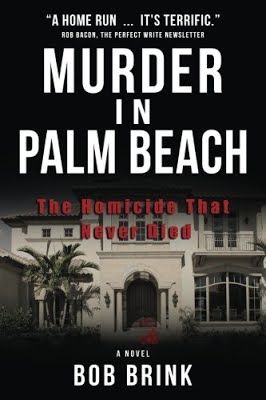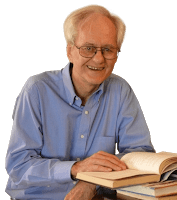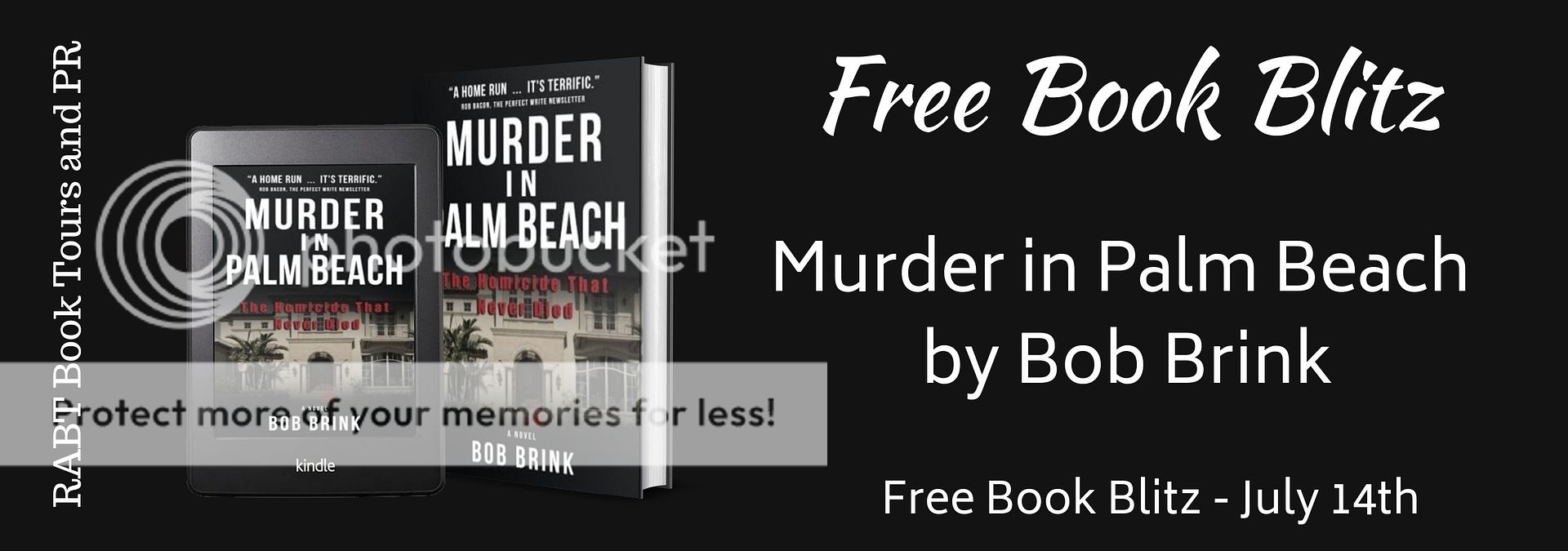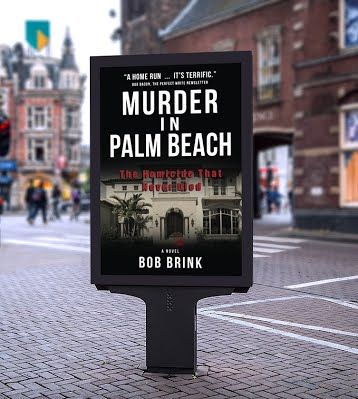
Murder Mystery
Publisher: Precipice Press
The doorbell rings in the home of a prominent Palm Beach citizen, quickly followed by a shotgun blast that shatters a window, cracking the calm of a cool January night. Rodger Kriger falls to the floor, mortally wounded, leaving a wife and six children.
Murder in Palm Beach: The Homicide That Never Died is closely based on a sensational, real murder that happened in the posh ocean-side town in 1976. In the thin guise of fiction, the book contains shocking new information never before made public. Author Bob Brink, an award-winning journalist, was a newspaper reporter in the locale where the assassination occurred. It made media headlines for 15 years.
An ambitious prosecutor pins the deed on Mitt Hecher, a hoodlum and karate expert. At Hecher’s trial, fellow jail inmates testify that he confessed. He is convicted and sentenced to the brutal and anarchic state prison at Raiford, where a stabbing a day and a killing a week are the “mean” average.
Judges repeatedly frustrate Hecher and several attorneys working without fees to get a new trial, as investigators pursue myriad scenarios. Meanwhile, his wife contracts a deadly disease.
Was Hecher innocent, and if so, who did it? Did the sons of a wealthy Cuban kill Kriger? Were the operators of a gambling enterprise out to get him? Was a love triangle the basis for the shooting? Did a vicious underworld figure do the bidding of a criminal gang? Was a prominent politician behind the slaying? Those are the questions seeking answers amid the exploration of issues of justice and power.
Murder in Palm Beach is the saga of a battle between a man whose swagger has sent him spiraling to the bottom and powerful, sinister forces determined to keep him there. It is a narrative of redemption wrapped in a mystery tale reeking with power, sex, and violence. It also contains a heart-rending love story.
Excerpt
“Johnny Traynor?” “Who’s this?”
Palladin did not remember him sounding timorous. “An acquaintance from way back. Tom Palladin.”
“Oh, yes. I remember. Haven’t seen you around for a long time.”
“I had a little difficulty finding your new number. Finally got it from a friend of yours, Davey Ross.”
“Oh, yeah, I moved inland a few years ago.”
“You used to live near the Shore Club. I thought you liked hanging out there. Why would you want to leave the neighborhood?
“Well … to tell the truth, things got a little dicey.” “You talking about the Kriger murder?”
“Well … uh … yeah, sort of.”
“I’d like to get together with you and chat about that. I have some new information.”
“Yeah, I guess so. I don’t know if I have anything that will help you.”
“Where do you live?”
Traynor gave directions to a duplex apartment on the west side of West Palm Beach.
“How about two p.m. tomorrow?” Palladin asked.
“Yeah, that’s okay. I’m working on a guy’s car, and I’ve got plenty of time to finish it.”
“See you then.”
The neighborhood was seedy. Most of the houses were small, run-down, wood-frame structures. Early-model cars and trucks, the paint usually fading, occupied driveways, littered lawns, or sat on the street in front. Patches of dried grass sprinkled with pale green contrasted with splotches of bare, sandy earth, like the shabby clothes of a tramp with tatters that revealed his skin. Traynor’s duplex was the only property on the block that didn’t look slummy to Palladin: a white, concrete-block structure with sidewalks leading to two screen doors opening to wooden front doors. Prosaic, but the grass was mostly green, and the car in the driveway, only a few years old, looked well-cared-for.
He parked on the street and walked to the unit on the right.
Opening the screen door, he knocked.
It struck Palladin like a light flipped on in a dark room.
Something was different about the man who opened the door. “Come in,” Traynor said. He gestured toward an armless,
cushiony chair. “Sit down. Want a beer? Or Coke? I mean, you want a Coca Cola?” Paladdin noticed he was unsteady.
“Thanks. Are you renting here?”
“No. I bought the duplex and rent out the other half. Gives me a little income.”
“Your place doesn’t look bad. Best one on the block.”
“I’ve gotta keep it up in order to rent it out. I rent it month-to- month and charge a big rate. A lot of my renters are people with criminal backgrounds like me who can’t find anyplace else. That’s why I bought this place. Nobody would rent to me.”
Palladin could see what had changed in the man. No longer exuding cocky self-confidence, he appeared timid, almost frightened. Sitting on the couch, smoking a cigarette, his hand trembled. Then it hit Palladin. Coke. The quick clarification of the offer of Coca Cola. Traynor was a cocaine addict.
“Let me tell you why I called. I found out something from a couple of sources. I know who shot Rodger Kriger.”
Palladin saw Traynor blanch. He looked without seeing at Palladin, then raised the cigarette to his lips with a shaky hand and took his time inhaling. He turned his head to blow the smoke away from his guest.
“I think you know who it is, too.”
Traynor leaned forward to the glass-topped coffee table
and snuffed his cigarette out in a small plastic ash tray. He straightened and looked away from Palladin, who noticed his face was grave.
“If it gets out that I told you this, I’ll prob’ly get killed.” He turned to look at Palladin. “You understand? You have to agree not to publish this.”
Palladin said he wouldn’t publish Traynor’s name, but would use the information he provided to dig for details about the murder. Traynor said he was okay with that.
“I drove the getaway car.”
About the Author

Bob Brink is a journalist who worked with the Palm Beach Post, The Associated Press in Chicago, Milwaukee Journal, Tampa Tribune, Joliet Herald-News, and Palm Beach Media Group (magazines). His byline has been on thousands of news stories, features, and entertainment reviews.
He has been a freelance writer for several years, and is the author of several books. To promote his current novel, MURDER IN PALM BEACH: The Homicide That Never Died, he has a website, www.bobbrinkwriter.com. From the site, he blogs on three passions: grammar, alternative health care, and socio-political issues.
Brink’s first book, A TALE OF TWO CONTINENTS: Jetting Across the Globe to Have a Baby, is a short memoir that he ghost-wrote for a woman. Almost simultaneously, he authored BREAKING OUT, a coming-of-age novel about a troubled young man. Recently, he compiled a book of short stories titled THE WAY IT WAS: Short Stories and Tall Tales.
Brink has won numerous writing accolades and several awards, including three for Palm Beach Illustrated, which won the Best Written Magazine award from the Florida Magazine Association after he became copy chief and senior writer.
He was a reporter for the Palm Beach Post when the crime that MURDER IN PALM BEACH is based on occurred. It was an enormously sensational event that was featured six years later on a national TV show, and made newspaper headlines for 15 years. A karate expert went to prison for the deed, but many doubted his guilt. A newspaper reporter spent years investigating, and made shocking discoveries about the assassination and the person behind it.
Besides dabbling in short-story writing over the years, Brink immersed himself in learning to play the clarinet and tenor saxophone. He performed many years with an estimable, 65-piece community symphonic band, and played a few professional big band gigs. He relegated music to the back seat after embarking on writing novels. He is a fairly proficient ballroom dancer and a health enthusiast.
A product of Michigan and Iowa, Brink has a bachelor’s degree in English from Drake University in Des Moines and completed graduate journalism studies at the University of Iowa.
Contact Links
Purchase Links




thanks for hosting
ReplyDelete